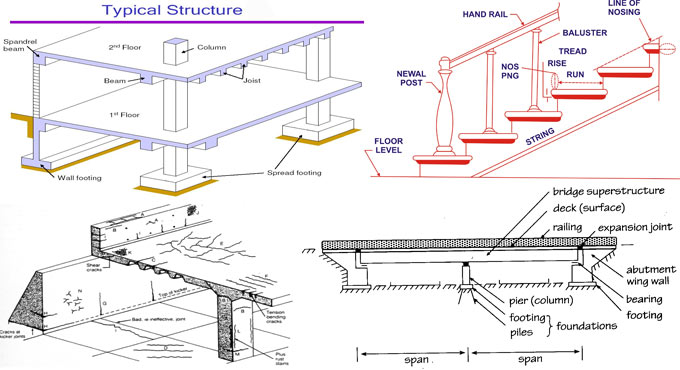
Some useful technical terms in civil engineering
AASHTO: American Association of State Highway and Transportation Officials.
ABILITY (Strength of Materials): The native properties of a material to react to the stresses generated from outside, (as for instance - absorption ability, de formation ability).
ABILITY BENDING TEST: This test is undertaken to examine the capacity of steel to sustain bending stresses devoid of major derogations of its internal structure.
A test bar placed on two parallel supports is twisted with a round punch pressed in the centre of the bar. There should be no cracks either on the edge or convex faces of the fold in the bar.
ABLATION
1. Loss of mineral substance of a rock because of Erosion.
2. The corroding of a river bed because of the combined abrasive action of water and waterborne substances in it.
ABNORMAL COLORING
Faults (Building Materials): Change in color in wood due to a change of its chemical composition as well as of its properties. The wood becomes unacceptable for application due to this fault.
ABNORMAL CONTACTS
Faults (Civil Engineering Structure): Owing to bad design or bad adjustment of the suspension, parasitic contacts are found among the mechanically independent parts. These contacts can happen among cables or distinct layers or with a part of the structure like abutment, deck, parapet, etc.
ABNORMAL PERMANENT SAG
Faults (Construction): It is abnormal sag of a part or a complete span in the absence or existence of any incidental overload on the complete work. The abnormal sag is consistent or evolving and it happens for different reasons like a geometrical fault throughout construction; a rise in the permanent load, or a reduction of the bearing strength of the structure; an accidental loading on a segment of the structure.
ABRASION: It is a wearing fact for which a loss of metal mass occurs because of the mechanical action of an external body. Or, the decay of stones or bricks because of the elimination of matter on the surface by solid bodies conveyed by water or air. Abrasion can be superficial or deep.
ABRASION RESISTANCE: In building materials, the resistance strength in a material that resists surface wearing due to the action, intentional or not, of another material or fluid.
ABSOLUTE POROSITY OF STONE: In building materials, it refers to the segment of the volume of the voids to the total apparent volume of the stone, the void along with the volume occupied by both imbibition and hygrometric water (exclusive of combination Water).
ABSOLUTE DENSITY: The definite volume of the particles of a segment of ground that is supposed to be exclusive of voids; it is known as YS.
ABUTMENT
Construction: It is the end bearing of a deck, a vault, a beam or an arch. Abutments are vital components of a bridge and their morphologies are relatively different. A bridge comprises of arches, vaults, or decks, and the abutment provides supports to these structures and attaches the bridge to the natural rock by usually supporting the earth pressure. For arches or vaults, the abutment supports the pressure of these structures. Abutments are made of masonry, concrete, reinforced concrete, possibly pre-stressed concrete, and even in curtains of sheet piles. Abutments normally contain a front wall and lateral walls called wing walls or return walls in relation to their location.
ABUTMENT PIER
Construction: It stands for a half-arch-shaped pillar for keeping a wall or a vault in order to make it stronger. It is combined with arched buttress, flying buttress.
1. A pier is arranged among two unequal arches or among a masonry arch and a metal span.
2. In a viaduct with equal arches, a pier that illustrates an allowance correspond to the others (one on four or five) and that is buttressed on the lateral part. This type of construction is used to resist the damage of the work if an arch ruptures.
3. A construction that can withstand a strongly inclined force.
ABYSSINIAN WELL
Foundation: It is similar to the well point. It belongs to a pointed tube having evenly placed perforations, through which water enters in the tube and directed into the ground. Water is then excavated from it through pumping.
Article Source: http://clearload.bid


